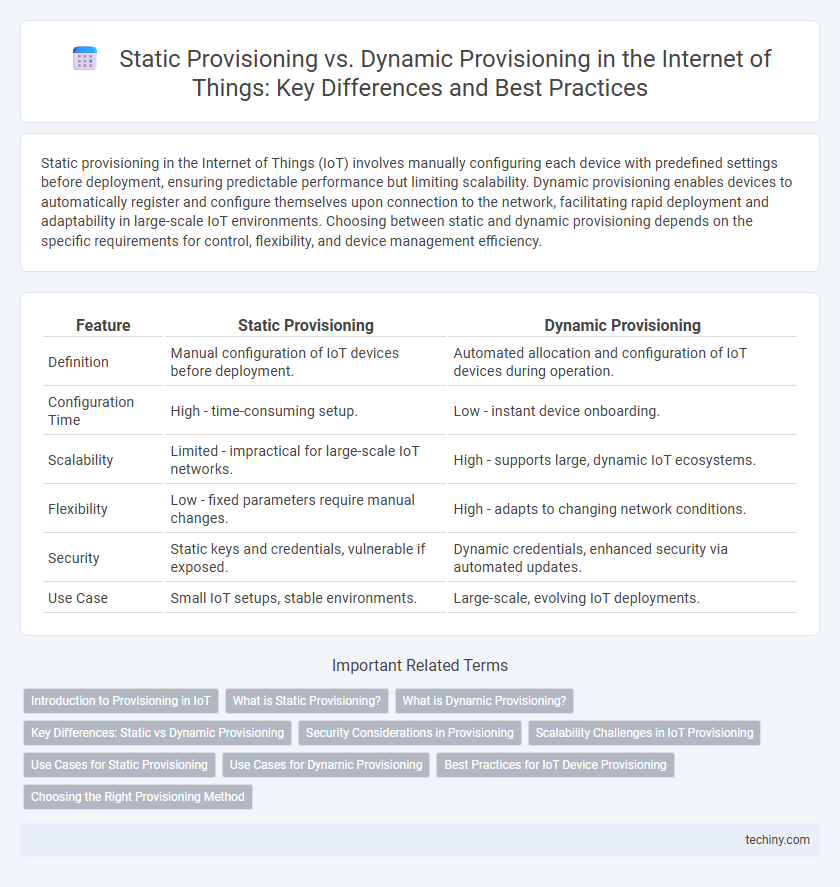Static provisioning in the Internet of Things (IoT) involves manually configuring each device with predefined settings before deployment, ensuring predictable performance but limiting scalability. Dynamic provisioning enables devices to automatically register and configure themselves upon connection to the network, facilitating rapid deployment and adaptability in large-scale IoT environments. Choosing between static and dynamic provisioning depends on the specific requirements for control, flexibility, and device management efficiency.
Table of Comparison
| Feature | Static Provisioning | Dynamic Provisioning |
|---|---|---|
| Definition | Manual configuration of IoT devices before deployment. | Automated allocation and configuration of IoT devices during operation. |
| Configuration Time | High - time-consuming setup. | Low - instant device onboarding. |
| Scalability | Limited - impractical for large-scale IoT networks. | High - supports large, dynamic IoT ecosystems. |
| Flexibility | Low - fixed parameters require manual changes. | High - adapts to changing network conditions. |
| Security | Static keys and credentials, vulnerable if exposed. | Dynamic credentials, enhanced security via automated updates. |
| Use Case | Small IoT setups, stable environments. | Large-scale, evolving IoT deployments. |
Introduction to Provisioning in IoT
Provisioning in IoT involves the process of configuring devices with necessary credentials, settings, and permissions to securely connect and communicate within a network. Static provisioning assigns fixed configurations manually or through preloaded parameters, ensuring predictable device behavior but limiting flexibility. Dynamic provisioning automates device registration and configuration using cloud-based platforms or protocols like Lightweight M2M, enabling scalable and adaptive deployment of IoT devices.
What is Static Provisioning?
Static provisioning in the Internet of Things (IoT) refers to the manual configuration of devices with fixed network settings, such as IP addresses, security credentials, and connection parameters, before deployment. This method ensures predictable device behavior and streamlined management in controlled or small-scale IoT environments. Static provisioning is often contrasted with dynamic provisioning, which automates device configuration through protocols like DHCP or Zero-touch onboarding to support scalability and flexibility.
What is Dynamic Provisioning?
Dynamic provisioning in the Internet of Things (IoT) refers to the automated process of configuring and managing devices in real-time as they connect to the network, enabling seamless scalability and adaptability. Unlike static provisioning, which requires manual setup and predefined configurations, dynamic provisioning uses protocols like MQTT and CoAP to assign device credentials, update firmware, and allocate resources on demand. This approach enhances operational efficiency, reduces deployment time, and supports large-scale IoT ecosystems with diverse and evolving device populations.
Key Differences: Static vs Dynamic Provisioning
Static provisioning in the Internet of Things (IoT) involves pre-configuring devices with fixed settings and credentials before deployment, ensuring predictable behavior but limited flexibility. Dynamic provisioning enables devices to obtain configuration data and authentication credentials automatically from centralized servers during initialization, supporting scalability and real-time management across diverse IoT ecosystems. Key differences include static provisioning's reliance on manual setup versus dynamic provisioning's automated, on-demand configuration, which enhances device onboarding efficiency and adaptability to changing network conditions.
Security Considerations in Provisioning
Static provisioning assigns fixed credentials and configurations to IoT devices, increasing vulnerability to attacks due to lack of flexibility in updating security parameters. Dynamic provisioning uses automated, real-time credential generation and device authentication, enhancing protection against unauthorized access and mitigating risks associated with credential leakage. Implementing dynamic provisioning significantly strengthens IoT security by enabling continuous verification and minimizing static attack surfaces.
Scalability Challenges in IoT Provisioning
Static provisioning in IoT involves pre-configuring devices with fixed settings, which limits scalability as the number of devices increases exponentially, leading to inefficient resource allocation and management. Dynamic provisioning leverages automated, on-demand configuration and real-time device registration, effectively handling large-scale IoT deployments by adapting to changing network conditions and device requirements. Scalability challenges in IoT provisioning stem from diverse device types, fluctuating connectivity, and the need for seamless integration, making dynamic provisioning essential for maintaining system performance and operational agility.
Use Cases for Static Provisioning
Static provisioning in the Internet of Things (IoT) is ideal for applications with fixed device configurations and predictable network environments, such as industrial automation and smart metering. It enables pre-configured devices to connect seamlessly without the need for real-time adjustments, ensuring stable and secure communication. Use cases include factory systems where devices require minimal changes and energy-efficient buildings with consistent sensor deployments.
Use Cases for Dynamic Provisioning
Dynamic provisioning in the Internet of Things enables real-time device onboarding and configuration, essential for large-scale deployments like smart cities and industrial automation. This approach supports rapid scaling, remote management, and automatic updates, reducing manual intervention and operational costs. Use cases include instant activation of edge devices, adaptive resource allocation in connected vehicles, and flexible sensor integration for environmental monitoring.
Best Practices for IoT Device Provisioning
Static provisioning assigns fixed credentials and configurations to IoT devices before deployment, ensuring consistent device identity and security but lacks scalability for large networks. Dynamic provisioning automates device onboarding by securely generating credentials and configurations in real time, enhancing flexibility and reducing manual errors. Implementing best practices involves using secure key exchange protocols, maintaining a centralized device management system, and regularly updating device credentials to protect against unauthorized access.
Choosing the Right Provisioning Method
Choosing the right provisioning method for Internet of Things (IoT) devices depends on the scale and flexibility requirements of the deployment. Static provisioning involves manually configuring device credentials and settings before deployment, ensuring tight security control but limiting scalability. Dynamic provisioning leverages automated, cloud-based enrollment processes to enable rapid, large-scale device onboarding and real-time configuration updates, making it ideal for complex IoT networks.
Static provisioning vs Dynamic provisioning Infographic

 techiny.com
techiny.com